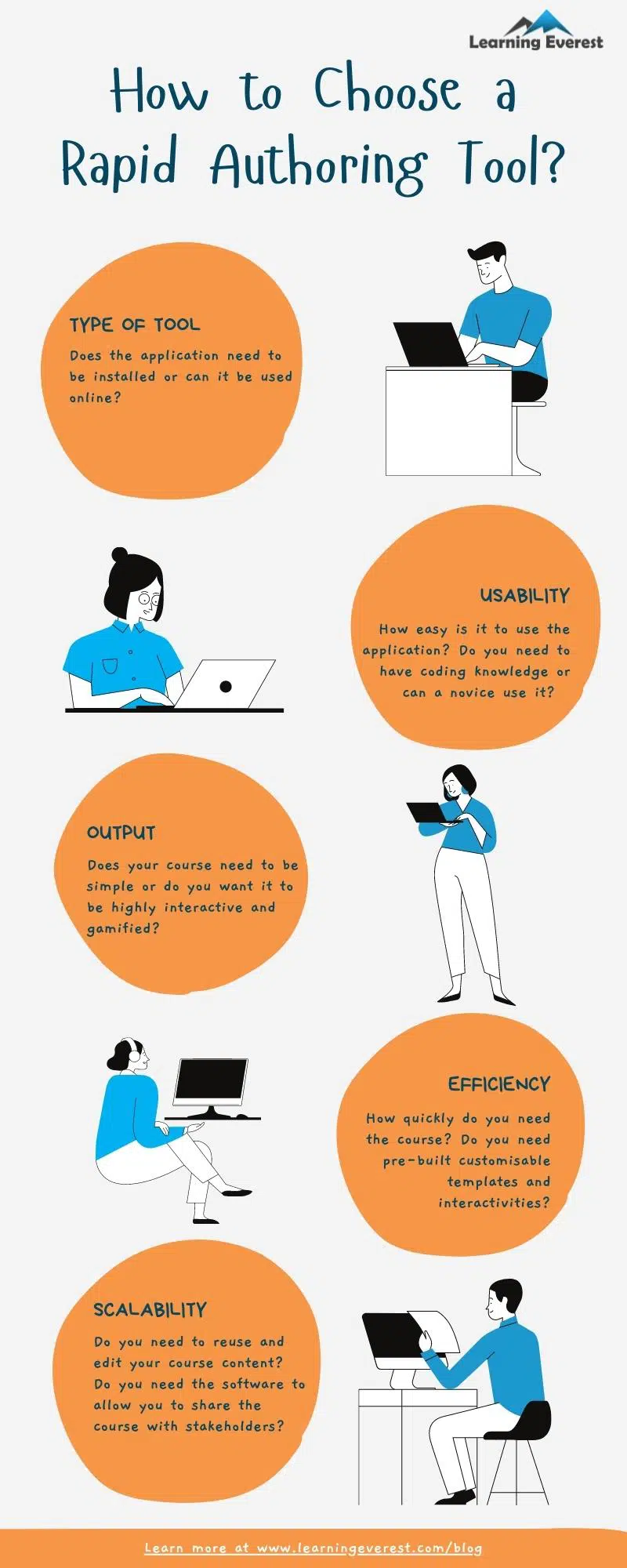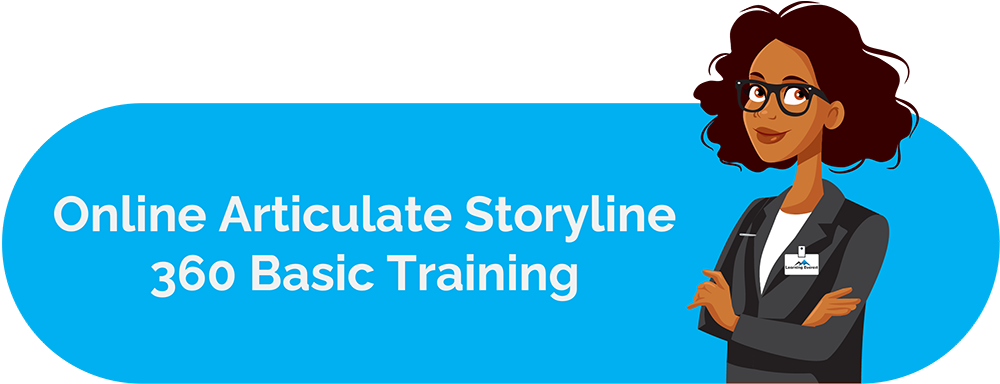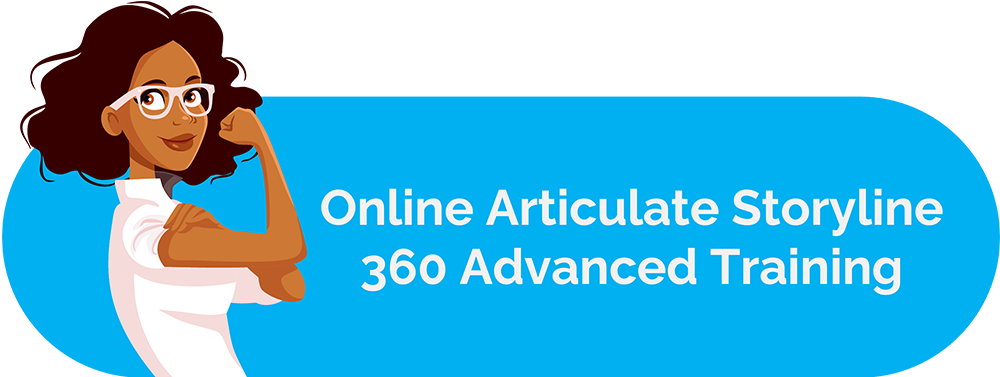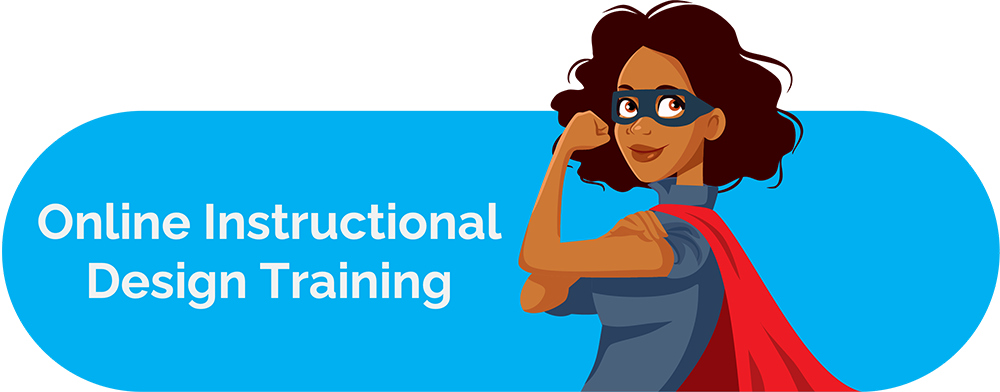When an organization requires a course to be built quickly or cost-effectively, they opt for rapid e-learning development. The instructional designer and developer use a rapid authoring tool to create such courses. These development softwares enable them to choose from pre-built customizable themes, templates, and interactivities to design courses faster and efficiently.
Table of Contents
How Should you Choose a Rapid Authoring Tool?
While choosing a rapid authoring tool that best suits their needs, one should see various criteria. It is not just about the pros and cons of the application. The user should look at the work they need to do and analyze its features accordingly.
There are two types of rapid authoring tools that can be used. These might require installation on your desktop as standalone apps or authoring suites, or they can be used online. If they are standalone applications, you might not have the option to share your work with collaborators and get their reviews. Authoring suites and online platforms usually have the option, but it’s best to check whether they do.
These also reduce the scalability of the application. The scalability sees how cost-effective the course is and whether the content can be reused or edited. Some applications are available for free, some as pay-as-you-use, and others require to be purchased in full. Your budget will also dictate which option you can choose.
Depending on who will be using the platform, usability also matters. Applications that are easier to use will also provide more straightforward outputs. If you wish to make your course highly interactive or gamify them, you will need developers to handle complex applications.
Accordingly, the speed and efficiency you can create a course will depend. If the course has pre-built templates and interactivities, it will take much less time to complete the course than those that need to be built from scratch.
What Authoring Tools are Available for e-Learning?
1. iSpring Suite
Type of tool: Authoring Suite
Usability: Easy
Output: Medium
Efficiency: Average
Scalability: Medium
iSpring Suite can be used on Windows. All you need is knowledge of PowerPoint to work around it. You can add interactivities, videos, voice narrations, characters and even quizzes to the course. The slides can then be directly converted and published to the LMS. However, if you want a non-linear approach or gamify the course, iSpring is not for you. iSpring is not available to Mac users.
2. Camtasia
Type of tool: Requires Installation
Usability: Easy
Output: Medium
Efficiency: Medium
Scalability: Low
Camtasia is essentially a video capturing tool. It enhances a PowerPoint and can be directly converted and uploaded to the LMS. Once uploaded, you won’t be able to make any changes. The features are like any video editing software. If you need to make video tutorials, product demos, or lessons, it is a great software to use. You can also add layers to the videos to increase interactivity.
3. Easygenerator
Type of tool: Can be used Online
Usability: Easy
Output: Low
Efficiency: Fast
Scalability: Low
With Easygenerator, you don’t need to know coding to control your content. You can use a pre-built template to get started. There are many features and interactivities available for use. It is also compatible with almost all LMS. However, while it is mobile-friendly, all the features are not optimized across all devices. You won’t be able to use your maximum creativity to design assessments but can contact the customer service prompt with their responses.
4. Articulate Rise
Type of tool: Can be used Online
Usability: Easy
Output: Low
Efficiency: Fast
Scalability: Medium
Articulate Rise is a rapid authoring tool, part of the Articulate 360 suite. It contains pre-built designs wherein only the content needs to be filled in. It is easy to use and does not require coding knowledge. It can be optimized across all devices. Many interactive features are available, like image galleries, timelines, processes, labeled graphics, etc. If you are looking for a basic, user-friendly platform, this is the one to use, but you won’t be able to mix up the presentation or gamify it.
5. Evolve
Type of tool: Can be used Online
Usability: Easy
Output: Medium
Efficiency: Fast
Scalability: Medium
Evolve is easy to use and has a range of elements and interactivities to choose from. This makes course creation faster. The courses are supported on multiple devices. You can collaborate and review with other stakeholders. You even pay only for the time you use the platform. However, if you want to create a gamified or branched course, Evolve isn’t for you.
6. Adapt
Type of tool: Can be used Online
Usability: Medium
Output: Low
Efficiency: Fast
Scalability: Medium
Adapt allows developers to add new interactivities to the community. The elements available are made by and for the users. The finished product appears in block forms. So even with customizations, they might look similar. You will have to preview what you are constantly designing to understand how it looks. The good part is that it is free, and you can even reuse your courses.
7. DominKnow ONE
Type of tool: Can be used Online
Usability: Medium
Output: High
Efficiency: Average
Scalability: Medium
DominKnow ONE is a mix of the authoring tool Claro and DominKnow Flow. You can customize pre-built themes, import your PowerPoint, choose from various interactivities, and reuse the page. There is an option to share your work and collaborate with others by receiving their reviews online. It can be a little tricky to use at first, but minimal training will get you going.
8. Gomo
Type of tool: Can be used Online
Usability: Easy
Output: Medium
Efficiency: Fast
Scalability: High
With various themes to choose from, Gomo is an easy-to-use platform. There are limited customizations available, but it gives the courses a quick turnaround. Courses made on Gomo can be accessed on the web or the Gomo app. Stakeholders can collaborate and provide their feedback. Learners can even choose which language they wish to take the course in.
9. Elucidat
Type of tool: Requires Installation
Usability: Medium
Output: High
Efficiency: Fast
Scalability: High
Elucidat creates complex courses, easy sharing, and optimization across all devices. There is a range of pre-built templates and interactivities to choose from, and you can also make complex gamified courses. This enables both coders and non-coders to work on this platform. You can even reuse your content by saving the pages. Moreover, Elucidat allows inviting the team to collaborate on the platform itself.
10. Adobe Captivate
Type of tool: Requires Installation
Usability: Complex
Output: High
Efficiency: Slow
Scalability: Low
Adobe Captivate is a complex platform to use. Knowledge of PowerPoint helps to some extent. One needs the training to navigate through all its features and create gamified courses. Once you learn, you can make the courses highly interactive, including giving the learner a virtual reality experience. Some of its features can be shared, but it isn’t easy to reuse the rest.
11. Lectora Inspire
Type of tool: Requires Installation
Usability: Complex
Output: Medium
Efficiency: Slow
Scalability: Medium
Lectora Inspire has been around for a long time and requires experienced users to develop a course. You can customize the pre-built templates through the development interface for professional-looking web content. This platform requires time to produce content, which also applies to translation. If there are changes in the file, you will have to change them for all the translated files manually.
12. Articulate Storyline 360
Type of tool: Authoring Suite
Usability: Complex
Output: Medium
Efficiency: Slow
Scalability: Low
The basic interface of Articulate Storyline 360 is like PowerPoint, but the content created can be far more complex and customized. This platform allows the creation of highly gamified courses. You will require some coding background to use all its features. It is one of the most popular authoring tools designers, and developers use. The major challenge arises if you need to change the contents or flow of the course.
Now that you have an idea of what features the rapid authoring tools offer choose based on your requirements!
Infographics

How to Choose a Rapid Authoring Tool






